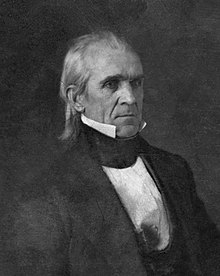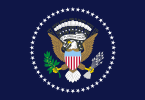James K. Polk - Simple English Wikipedia, the free encyclopedia
This article includes a list of references or other websites, but its sources remain unclear because it does not have enough inline citations. (December 2020) |
This article relies largely or entirely on a single source. (December 2020) |
James K. Polk | |
|---|---|
 Portrait c. 1849 | |
| 11th President of the United States | |
| In office March 4, 1845 – March 4, 1849 | |
| Vice President | George Dallas |
| Preceded by | John Tyler |
| Succeeded by | Zachary Taylor |
| 9th Governor of Tennessee | |
| In office October 14, 1839 – October 15, 1841 | |
| Preceded by | Newton Cannon |
| Succeeded by | James Jones |
| 17th Speaker of the United States House of Representatives | |
| In office December 7, 1835 – March 4, 1839 | |
| President | Andrew Jackson Martin Van Buren |
| Preceded by | John Bell |
| Succeeded by | Robert Hunter |
| Member of the U.S. House of Representatives from Tennessee's 9th district | |
| In office March 4, 1833 – March 4, 1839 | |
| Preceded by | William Fitzgerald |
| Succeeded by | Harvey Watterson |
| Member of the U.S. House of Representatives from Tennessee's 6th district | |
| In office March 4, 1825 – March 4, 1833 | |
| Preceded by | John Cocke |
| Succeeded by | Balie Peyton |
| Personal details | |
| Born | James Knox Polk November 2, 1795 Pineville, North Carolina, U.S. |
| Died | June 15, 1849 (aged 53) Nashville, Tennessee, U.S. |
| Resting place | Tennessee State Capitol Nashville, Tennessee |
| Political party | Democratic |
| Spouse(s) | Sarah Childress |
| Alma mater | University of North Carolina, Chapel Hill |
| Profession | Lawyer Planter |
| Signature | |
James Knox Polk (November 2, 1795 – June 15, 1849) was the 11th president of the United States. He only served one term as president. Before he was president, he was Speaker of the House of Representatives (1835–1839) and the governor of Tennessee (1839–1841).
Early life[change | change source]
James Knox Polk was born on November 2, 1795 in Pineville, North Carolina. His parents were Samuel Polk and Jane Gracey Polk. James’ father was an American surveyor, slave owner, planter, and businessman. It is unknown what his mother did. It is thought she was a housewife. He was very sickly as a child, so he did not do much farm work. He had surgery at 17 years old to remove bladder stones. Anesthesia was not invented yet, so he was awake the entire surgery. He was in a debate club in college. Polk studied law under a leading Nashville lawyer. He then worked as a lawyer and a statesman. He married Sarah Childress on January 1, 1824. They had no children together.
Presidency[change | change source]
The Democratic Party named Polk as their choice for the 11th President of the United States in May 1844. He won the election in November and started his term on Tuesday, March 4, 1845. Polk's vice president was George M. Dallas. During Polk’s four years in office, he got to do a lot of the things he wanted to do. He restarted the Independent Treasury System (a way for the U.S. to manage its money) after one of the presidents before him stopped it. He also made tariffs (taxes on items moving between the U.S. and other countries) smaller. The most important thing Polk did was add more land to the U.S. He got more land in Oregon Country by making an agreement with Britain.[1] He also let Texas join the United States.[2] That made Mexico's government angry and caused the Mexican–American War.[3] The U.S. won the war, so Polk got more land from Mexico. He succeeded at the four most important things he wanted to do during his presidency.[4] Polk was not perfect though. The new land he got made the argument about slavery worse.[5] That argument was one of the causes of the Civil War.
Later life[change | change source]
James K Polk became a private citizen at the end of his 4 years in office. He and his wife decided to move to their Nashville home in Nashville, Tennessee because they wanted to retire and live a quiet life. Instead of directly returning to Tennessee, the Polks decided to tour the Southern states. Along the way he gave many speeches to the public. Within two weeks, James’ health suffered from the strains of travel. As the trip continued, the Polks were often forced to stop along the way to allow James to rest. The rest did not help. After arriving at their Nashville home, James Polk again fell ill and complained of horrible stomach pains. This time James had a serious disease called cholera. At the age of 53, James Knox Polk died on June 15, 1849. On his deathbed James asked his wife to free their slaves when she died. Sarah lived 42 more years and the Civil War freed their slaves long before she died. He was first buried at the Nashville City Cemetery then moved to his Nashville home but was later moved to the Tennessee state capitol after his Nashville home was later sold. He had the shortest retirement of any president, dying only three months after leaving office.[6]
References[change | change source]
- ↑ Merry, Robert W. (2009). A Country of Vast Designs: James K. Polk, the Mexican War, and the Conquest of the American Continent. New York: Simon & Schuster. pp. 266-267. ISBN 978-0-7432-9743-1.
- ↑ Merry, Robert W. (2009). A country of vast designs: James K. Polk, the Mexican War and the conquest of the American continent. New York (N. Y.): Simon and Schuster. pp. 211-212. ISBN 978-0-7432-9743-1.
- ↑ Borneman, Walter R. (2008). Polk: the man who transformed the presidency and America (1st ed.). New York, NY: Random House. ISBN 978-1-4000-6560-8.
- ↑ Merry, Robert W. (2009). A country of vast designs: James K. Polk, the Mexican War and the conquest of the American continent. New York (N. Y.): Simon and Schuster. pp. 131-132. ISBN 978-0-7432-9743-1.
- ↑ Merry, Robert W. (2009). A country of vast designs: James K. Polk, the Mexican War and the conquest of the American continent. New York (N. Y.): Simon and Schuster. pp. 458-459. ISBN 978-0-7432-9743-1.
- ↑ Digital, Muletown. "James K. Polk". James K. Polk Museum. Columbia, TN. Retrieved 2020-12-25.
Other websites[change | change source]
- Polk's White House biography Archived 2008-04-03 at the Wayback Machine


 French
French Deutsch
Deutsch


